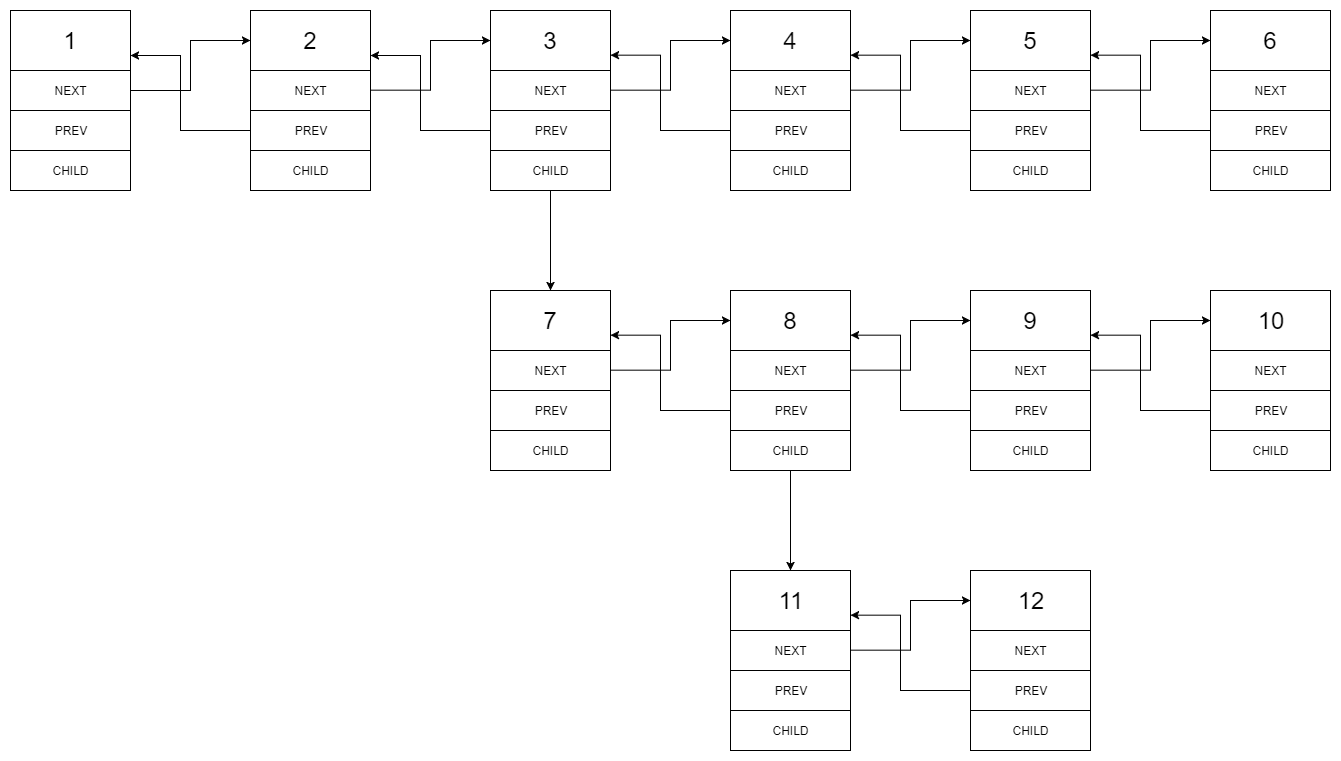Leetcode 430. Flatten a Multilevel Doubly Linked List (Python)
Related Topic
Depth-First-Search. Tree. Postorder-Traversal.
Description
You are given a doubly linked list which in addition to the next and previous pointers, it could have a child pointer, which may or may not point to a separate doubly linked list. These child lists may have one or more children of their own, and so on, to produce a multilevel data structure, as shown in the example below.
Flatten the list so that all the nodes appear in a single-level, doubly linked list. You are given the head of the first level of the list.
Sample I/O
For example, given the following tree:
Example 1
Input: head = [1,2,3,4,5,6,null,null,null,7,8,9,10,null,null,11,12]
Output: [1,2,3,7,8,11,12,9,10,4,5,6]
Explanation:
The multilevel linked list in the input is as follows:

After flattening the multilevel linked list it becomes:

Example 2
Input: head = [1,2,null,3]
Output: [1,3,2]
Explanation:
The input multilevel linked list is as follows:
1---2---NULL
|
3---NULL
Example 3
Input: head = []
Output: []
How multilevel linked list is represented in test case:
We use the multilevel linked list from Example 1 above:
1---2---3---4---5---6--NULL
|
7---8---9---10--NULL
|
11--12--NULL
The serialization of each level is as follows:
[1,2,3,4,5,6,null]
[7,8,9,10,null]
[11,12,null]
To serialize all levels together we will add nulls in each level to signify no node connects to the upper node of the previous level. The serialization becomes:
[1,2,3,4,5,6,null]
[null,null,7,8,9,10,null]
[null,11,12,null]
Merging the serialization of each level and removing trailing nulls we obtain:
[1,2,3,4,5,6,null,null,null,7,8,9,10,null,null,11,12]
Constraints:
- Number of Nodes will not exceed 1000.
- 1 <= Node.val <= 10^5
Methodology
This question can be solved by Depth First Search. It is similar with question 114. Flatten Binary Tree to Linked List. The difference is using doubly linked list this time.
Start traversing the double linked list. Once meet a node with child, we first store the current node’s next node. Then we connect the current node to child node and traversal child node. After done traversing child node, we want to connet the tail of child node to the original current node’s next node. We can use dfs to recursivly connect the child node and even child’s child node.
As this is doubly linked list, do not forget the prev pointer.
Code
def flatten(self, head: 'Node') -> 'Node':
if head is None: return None
def flattenChild(node):
if node.next is None: return node
while node and node.next:
if node.child:
tmp = node.next
node.next, node.child.prev= node.child, node
node.child = None
node = flattenChild(node.next)
node.next, tmp.prev= tmp, node
node = node.next
return node
node = head
while node:
if node.child:
tmp = node.next
node.next, node.child.prev= node.child, node
node.child = None
node = flattenChild(node.next)
if tmp:
node.next, tmp.prev= tmp, node
else:
node = node.next
return head
BigO
We traversal all nodes once so the total time complexity is O(n)